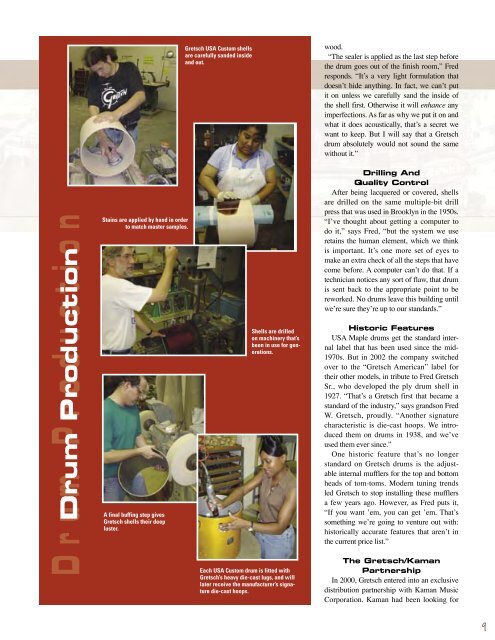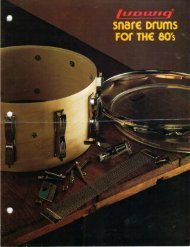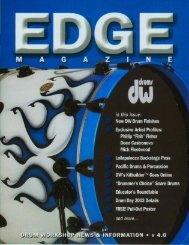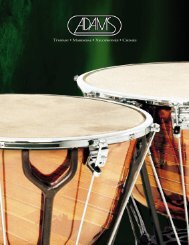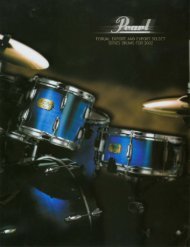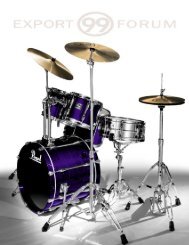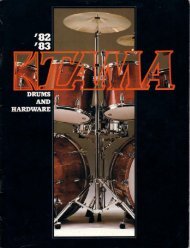You also want an ePaper? Increase the reach of your titles
YUMPU automatically turns print PDFs into web optimized ePapers that Google loves.
� � ���������������� � � � � � � � � � � � �<br />
������������������������������������<br />
������������������������<br />
���������������������������<br />
��������������������������<br />
�������<br />
��������������������������<br />
����������������������������<br />
��������<br />
�������������������<br />
��������������������<br />
��������������������<br />
���������<br />
������������������������������������<br />
����������������������������������������<br />
���������������������������������������<br />
��������������������<br />
wood.<br />
“The sealer is applied as the last step before<br />
the drum goes out of the finish room,” Fred<br />
responds. “Itʼs a very light formulation that<br />
doesnʼt hide anything. In fact, we canʼt put<br />
it on unless we carefully sand the inside of<br />
the shell first. Otherwise it will enhance any<br />
imperfections. As far as why we put it on and<br />
what it does acoustically, thatʼs a secret we<br />
want to keep. But I will say that a <strong>Gretsch</strong><br />
drum absolutely would not sound the same<br />
without it.”<br />
�������������<br />
���������������<br />
After being lacquered or covered, shells<br />
are drilled on the same multiple-bit drill<br />
press that was used in Brooklyn in the 1950s.<br />
“Iʼve thought about getting a <strong>com</strong>puter to<br />
do it,” says Fred, “but the system we use<br />
retains the human element, which we think<br />
is important. Itʼs one more set of eyes to<br />
make an extra check of all the steps that have<br />
<strong>com</strong>e before. A <strong>com</strong>puter canʼt do that. If a<br />
technician notices any sort of flaw, that drum<br />
is sent back to the appropriate point to be<br />
reworked. No drums leave this building until<br />
weʼre sure theyʼre up to our standards.”<br />
�����������������<br />
USA Maple drums get the standard internal<br />
label that has been used since the mid-<br />
1970s. But in 2002 the <strong>com</strong>pany switched<br />
over to the “<strong>Gretsch</strong> American” label for<br />
their other models, in tribute to Fred <strong>Gretsch</strong><br />
Sr., who developed the ply drum shell in<br />
1927. “Thatʼs a <strong>Gretsch</strong> first that became a<br />
standard of the industry,” says grandson Fred<br />
W. <strong>Gretsch</strong>, proudly. “Another signature<br />
characteristic is die-cast hoops. We introduced<br />
them on drums in 1938, and weʼve<br />
used them ever since.”<br />
One historic feature thatʼs no longer<br />
standard on <strong>Gretsch</strong> drums is the adjustable<br />
internal mufflers for the top and bottom<br />
heads of tom-toms. Modern tuning trends<br />
led <strong>Gretsch</strong> to stop installing these mufflers<br />
a few years ago. However, as Fred puts it,<br />
“If you want ʼem, you can get ʼem. Thatʼs<br />
something weʼre going to venture out with:<br />
historically accurate features that arenʼt in<br />
the current price list.”<br />
������������������<br />
�����������<br />
In 2000, <strong>Gretsch</strong> entered into an exclusive<br />
distribution partnership with Kaman Music<br />
Corporation. Kaman had been looking for<br />
9


